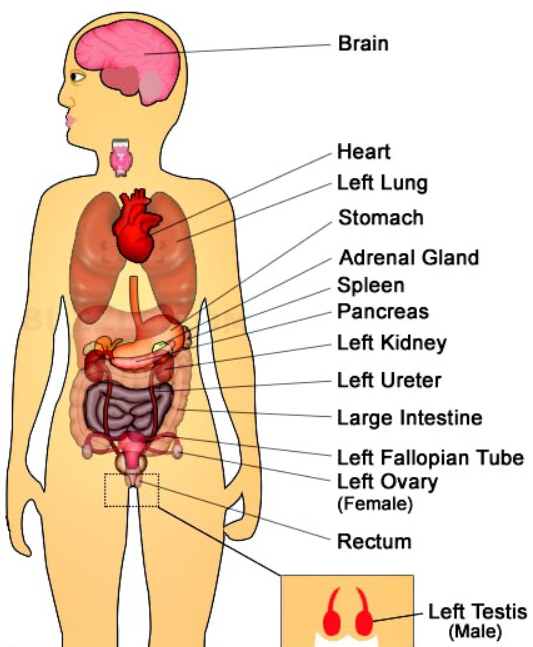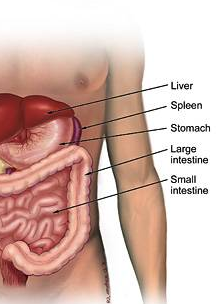Organ means a group of tissues in a living organism that have been adapted to perform a specific function. In higher animals, organs are grouped into organ systems; for example, the esophagus, stomach, and liver are organs of the digestive system. Do you think you know your body really well? If yes, you need to think twice. Our body is with us all the time but we can't say that we know everything about it.
What Organs Are on the Left Side?
Major Organs
- Heart
The exact position of heart is marginally toward the breastbone of the left side. Both the sides of heart are separated by a solid wall known as septal wall. Each side contains 2 chambers from which the upper ones are called atria and lower ones are ventricles. The atria are smaller in size than ventricles and are used to hold the blood before transferring to the ventricles. The atrium and ventricle of left side are thicker than the right side.
- Stomach
The area that loads up the food we eat in the digestive system is called stomach. The stomach is responsible for digestion of food and to secrete enzymes that aid in assimilation and absorption of digested food. Stomach is located on the upper side of abdomen. The upper end of stomach is guarded by pyloric sphincter that aids in the passage of food towards the small intestines.
- Spleen
The spleen is positioned in the left upper side of abdomen. It is an organ 4 inches long, responsible for producing new blood cells and removing useless cells. Spleen is also responsible for filtration of blood and fighting bacteria which can cause diseases like meningitis and pneumonia. It also controls and assists water distribution throughout the body. A weak spleen can cause water retention in certain areas of the body as well as weak immune system.
- Pancreas
Pancreas, a vital digestive gland found at the back of stomach. The gland has both endocrine and exocrine components with length of up to 6 inches. The head of pancreas is located along the right side of abdomen. The tail of pancreas is a narrow end that is extended towards the left area of the body. It is responsible to absorb and process the vital nutrients including carbs, proteins and fats, and also release digestive enzymes in the duodenum.
- Large Intestines
Large intestines are present under the cavity of abdomen and is joined by the rear end of small intestines. There is a list of organs present in large intestines which includes colon, rectum and cecum. The cecum basically starts from the right lower side. It first rises and crosses and then slides down into the colon parts before entering the right lower part of rectum.
They are responsible for getting water from food elements that are taken in by the human body, and storage of feces before these are excreted from the body.
Paired Organs
Since you have already had some knowledge about what organs are on the left side of the body, especially some major organs, you may want to know more about the paired organs in our body as they are equally important for the function of our activities.
- Left Lung
Lungs are basically responsible for the respiration that is accomplished by inhalation of oxygen and exhalation of carbon dioxide. Both lungs are located on either side of thorax and appear like a sponge. There exists a trachea which passes the air towards the lungs through bronchi--the tube like structures that resemble the branches. The size of left lung is smaller and narrower than the right one because the heart needs to be accommodated which is somewhat on the left side of the body.
- Left Breast
It is located on the anterior chest wall. Female breasts are way more developed than men's due to the need to provide infants with the nutrition at the time of nursing. The breast's growth is dependent on the estrogens and progesterone secretion in the body. The appearance of breasts can vary during the period of pregnancy, like the size increases to produce milk under the influence of Prolactin hormone. In most cases, the right and left breasts aren't similar due to an unknown reason. Very few females have symmetrical breasts.
- Left Kidney and Adrenal Gland
Kidneys are responsible for urea, toxins, mineral, salts and waste product filtration from the blood. The left kidney is positioned slightly higher than the right one because the right kidney is pressed downwards by the liver. The size of left kidney is almost the size of a fist.
At the top of the kidney sit adrenal or suprarenal glands. The adrenal glands of left and right side differ in size and shape. They are responsible for the management of hormone production.
4. Left Ureter
The ureter works like a pathway for urine when it travels from kidney to the bladder. In case of ureter malfunction, the kidneys are at risk of getting infected. The sinus of kidneys constricts to form the ureters but if we look at the anatomy, the right and left ureters are slightly different from each other. The left one is towards the side of inferior mesenteric nerve, while the right one is located towards the inferior vena cava.
Reproductive Organs
Now you have known what organs are on the left side of your body for all human being, but there are some differences in this part because no normal person will have the three following organs at the same time.
Left Fallopian Tube
Two fallopian tubes are placed separately on each side of uterus which then extend towards the ovaries, present on the opposite side of uterus.These structures are only present in females, and are responsible to capture the egg released from the ovaries. The fallopian tubes are also bound to maintain the health of the egg as it waits there for fertilization to take place.
Left Ovary
The sex hormones of female such as estrogen and progesterone are secreted by the almond shaped organs called ovaries. The production of egg also depends on the proper functioning of ovaries. Turns are taken by the ovaries of both sides every month for egg release. They are also responsible to secrete inhibin, which produces follicle-stimulating hormone (FSH).
Left Testis
Testis is only present in men. The testis is protected by scrotum, which looks like a sac, located in between anus and penis. The testis contains Leydig and Sertoli cells that are responsible for hormone production. In some men, the position of left testis is a bit higher than the right one and the left one is smaller in dimensions because of too much veins running above it.


